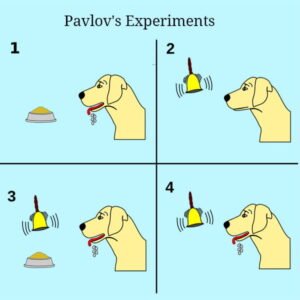By: Dr Carla Kesrouani
Categories:
Pavlov’s Experiments
Pavlov’s conditioning experiments on dogs in the early 1900s formed the basis for our understanding of classical conditioning. His work demonstrated how animals and humans can form associations that influence their behaviors.
Ivan Pavlov studied digestive physiology in dogs before making his famous discoveries about learning and conditioning. Let’s examine the key details of his pioneering experiments.
Who is Ivan Pavlov?

Ivan Pavlov (14 September 1849 – 27 February 1936) was a Russian physiologist who is best known for his discovery of classical conditioning, a learning process in which an association is formed between a stimulus and a response. Pavlov conducted experiments on dogs, in which he trained them to salivate at the sound of a bell by pairing it with food. He also studied the effects of various factors, such as the intensity, frequency, and timing of the stimuli, on the strength and duration of the conditioned response. Pavlov’s work had a profound impact on psychology, neuroscience, and behaviorism, as well as on fields such as education, medicine, and advertising.
What Were Pavlov’s Experiments?

Pavlov’s initial experiment sought to understand the digestive process in dogs. He measured how much saliva dogs naturally produced in response to food.
That is, the experiment was primarily physiological, and the psychological factor was not one of the goals on Ivan Pavlov’s research table before the start of the experiments.
So what happened until the trend differed in this way?
physiological to the psychological
But Pavlov noticed the dogs began to salivate BEFORE being fed – in response to the laboratory conditions themselves. This led him to study the conditions under which that “psychic secretion of saliva” occurred.
In his conditioning experiments, Pavlov presented a neutral stimulus – like a bell or light – right before food was given.
After repeating this pairing numerous times, the neutral stimulus alone began to produce salivating. The dogs had learned to associate that stimulus with the biologically significant event of receiving food.
This showed that environmental cues or events could become linked in the mind, forming the basis of classical conditioning.
What Did Pavlov Demonstrate?
Through observing the dogs’ acquired salivation responses, Pavlov demonstrated:
- Animals (and humans) form associations between stimuli that regularly occur close together in time
- A neutral stimulus – when paired with a reflex-provoking stimulus – can acquire the capacity to produce that reflex on its own
- Conditioned responses are similar to unconditioned (automatic) responses, though acquired through learning rather than innately
- Extinguishing conditioned responses involves repeatedly presenting the conditioned stimulus without the unconditioned one, breaking their association.
Pavlov’s findings revolutionized psychology by showing how environmental contingencies shape organisms’ behaviors, responses and emotions through simple associative learning.
What Are the Main Terms?

Several key concepts arose from Pavlov’s experiments:
- Conditioned stimulus: A previously neutral stimulus that, after conditioning, produces a response.
- Unconditioned stimulus: A stimulus that naturally and automatically produces a response.
- Conditioned response: A response to the conditioned stimulus acquired through learning.
- Unconditioned response: An automatic response to the unconditioned stimulus.
- Classical conditioning: The process of associating a previously neutral stimulus with a biologically significant one.
Pavlov’s observations about stimulus-response relationships, pairings and extinction laid the foundation for how psychologists understand and study learning today.
In summary
Pavlov’s pioneering classical conditioning experiments in dogs demonstrated how animals’ behaviors and responses can change through simple associative learning. His observations revealed general principles about learning and conditioning that form a cornerstone of modern psychology. In doing so, Pavlov shifted the field’s focus toward environmental and behavioral explanations of animal and human behavior.
In conclusion of our conversation here, I would like to invite you to follow us on social media, such as our page on Twitter, so that it will be a greater opportunity for communication and you will receive all new and useful from our website.


